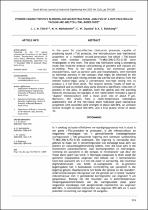Powder characteristics blending and microstructural analysis of a hot-pack rolled vacuum arc-melted gamma-tial-based sheet
Abstract
In the quest for cost-effective fabrication processes capable of producing sound γ-TiAl products, the microstructure and mechanical properties of a modified second-generation hot-rolled γ-TiAl-based alloy with nominal composition Ti-48Al-2Nb-0.7Cr-0.3Si were investigated in this work. The alloy was fabricated using a processing route that involved uniaxial cold-pressing of powders and vacuum arc re-melting. Prior to the cold pressing, the elemental powder characteristics, such as particle sizes and morphologies, were blended to minimise porosity in the compact that might be inherited by the final ingot. A hot-pack rolling process was carried out directly from the melted button-ingot using a conventional two-high rolling mill to produce a 4 mm-thick sheet. The relative density results of both as-compacted and as-melted alloy parts showed a significant reduction of porosity in the alloy. In addition, both the optical and the scanning electron microscopy micrographs of the rolled sheet revealed a typical 'duplex' microstructure with a mean grain size of about 9 urn. Moreover, the results from a room-temperature indentation plastometry test of the hot-rolled sheet indicated good mechanical properties with recorded yield strength of about 600 MPa, an ultimate tensile strength of about 850 MPa, and a true plastic strain of about 3%.

